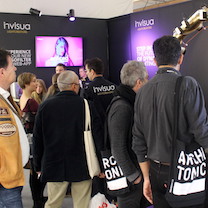
The ultimate lighting plan for museums and exhibition spaces
Museum lighting brings art to life
The museum lighting plays an important role in setting up permanent and temporary exhibitions in museums and exhibition spaces. With museum lighting, the right context and atmosphere can be created. And ensure that your visitors move through the exhibition in a natural way and that the masterpieces get the attention they deserve.
However, different starting points can be used when designing the lighting plan. In this blog, we discuss the considerations that are made when designing the ultimate lighting plan for museums and exhibition spaces.
Show optimally versus save
When designing the lighting plan, the optimal and clear display of the objects can be the main objective. Or there may be a strong consideration towards the preservation of the objects. The latter is an essential consideration, particularly with regard to vulnerable and very expensive objects. To see the shape, color and texture of the works, light is needed.
However, the same light can cause damage to materials that are sensitive to it. Even if there are small amounts of light. It only takes longer before the damage is visible. Light damage is permanent and worsens as fragile materials are exposed to light for longer. So, it is important to figure out a good balance between preserving the works on the one hand and being able to see the works well on the other.


Individual pieces versus the exhibition as a whole
Another consideration when designing the lighting plan for museum lighting is whether it is necessary to think from the optimal display of the individual objects, or from the exhibition as a whole. Is it an exhibition that is characterized by masterpieces that are used as a hero? Then you can choose to base the lighting plan on that. But when there is a fascinating museum building or impressive exhibition space, attention can be paid to the lighting of the exhibition as a whole. This makes the exhibition space attractive and inviting to watch. The lighting plan also lends itself well to creating different worlds through light when an exhibition is made up of different subjects or sub collections.

Strengthen the intention of the artist
Often, when designing the lighting plan, the objects and the exhibition space are examined. But where does that leave the artist who made the work. Under what circumstances are the works made? How warm or cold, intense or weak, for example, the light was when the artist was at work and the colors in the work were assessed. What message, intention or feeling does the artist want to convey with the work? When you reflect on that, the lighting plan can get a completely new turn.
Does the ultimate lighting plan exist?
Art is pre-eminently intended to stimulate people, to make people think, to talk and to discuss. Looking at all the ways in which art can be looked at, both literally and figuratively, we come to the conclusion that this also applies to the lighting plan. There is no one correct answer. What for an exhibition is ultimately from one perspective can turn out to be very disadvantageous from a different perspective. Not even mentioning other exhibitions. Designing a lighting plan for an exhibition is customization and people work. It supports the story of the artist, the space or the curator. The question is and remains, however, which argument or which approach weighs the heaviest. Whatever the answer, a flexible lighting solution always works.



































